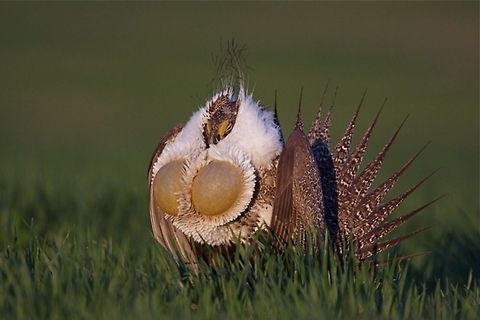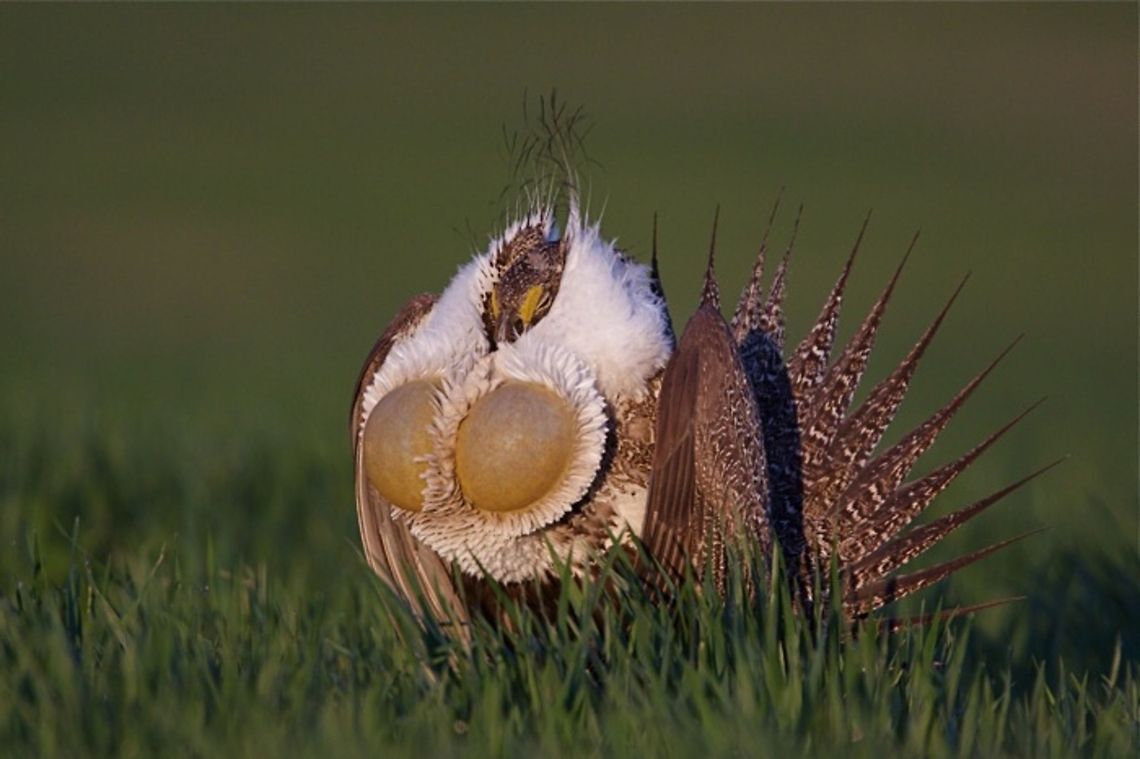
The Sage Grouse is the largest grouse in North America, where it is known as the Greater Sage-Grouse. Its range is sagebrush country in the western United States and southern Alberta and Saskatchewan, Canada. A population of smaller birds, known in the U.S. as Gunnison Sage-Grouse, were recently recognized as a separate species. The Mono Basin population of Sage Grouse may also be distinct.
Adults have a long, pointed tail and legs with feathers to the toes. Adult males have a yellow.. more
Similar species: Landfowl
By Tom Reichner
All rights reserved
Uploaded Oct 5, 2012. Captured Apr 23, 2010 06:18.


comments (10)
Oddly enough, they are not afraid of the tent (unless it's windy). Posted 13 years ago
Picture is just perfect also with golden morning/evening sun. Posted 13 years ago
This grouse knows how to get attention! The Greater Sage-grouse (Centrocercus urophasianus) is a large, charismatic bird that gets its name, food, and shelter from sagebrush (Artemisia sp.) in western North America. Early each spring, the Sagebrush Sea is filled with weird burbling and plopping sounds that are accompanied by an even stranger sight. Large groups of male grouse converge at their lek sites, which are traditional breeding grounds. This is where they will perform their famously outlandish courtship displays. They strut, fan their feathers, swell their gular sacs, and make utterly odd noises in the process. Their goal: to impress and gain a female mate....Or, as many mates as possible in some cases. Scientists have observed single individual males copulating with as many as 37 females. The pressure is intense for males because the one with the best display gets the most females. After mating, males play no role in rearing the young. Their job is simply to dance and mate. The females build nests nearby and raise the chicks.
Sage-grouse are indicators of healthy sagebrush habitat. They are obligate residents that need large expanses of sagebrush grasslands and hydrologic systems to survive. Sadly, loss of habitat, agriculture, overgrazing, the development of gas fields, and the effects of invasive plants have decimated their populations. There were once as many as 16 million sage-grouse in western North America. But, less than 10% remain. Sage-grouse are not pioneers—they can't and won't move on to new places when their homes are destroyed. They are habitual and return to the same leks each spring. As the sagebrush disappears and the land is developed, the grouse will be no more. Saving the sage-grouse benefits countless other species, such as migratory and resident birds, plants, pronghorn, trout, elk, pygmy rabbits, and mule deer. This isn't just about saving a quirky bird; rather, it's about saving the West and the species that live there. {Spotted in the United States by JungleDragon user, Tom Reichner} #JungleDragon Posted 6 years ago
Today’s Day 2 of our unusual ‘creature feature’ week! #JungleDragon
Check out our list to see more:
GULAR SACS
The greater sage-grouse (Centrocercus urophasianus) knows how to get attention! During mating season, groups of males fill the air with weird burbling and plopping sounds as they strut around, fan their feathers, and swell their gular sacs. Gular sacs are located on their necks and are inflated during courtship displays. The males with the most impressive performances score the most female mates. {Spotted in the United States by Tom Reichner} #Gularsacs #greatersagegrouse #Centrocercusurophasianus
https://www.facebook.com/jungledragonwildlife Posted 4 years ago